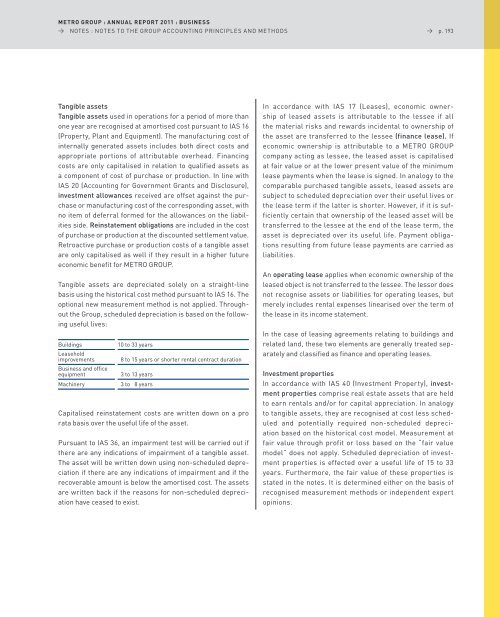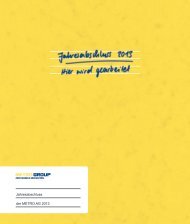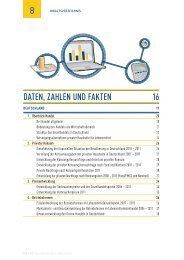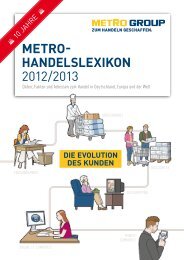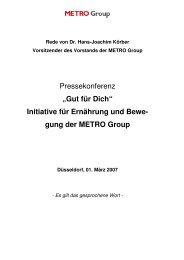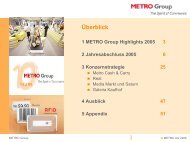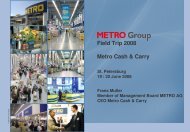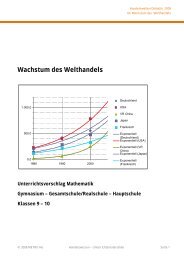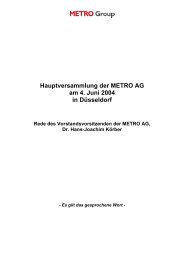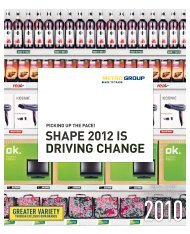pdf (22.8 MB) - METRO Group
pdf (22.8 MB) - METRO Group
pdf (22.8 MB) - METRO Group
Create successful ePaper yourself
Turn your PDF publications into a flip-book with our unique Google optimized e-Paper software.
<strong>METRO</strong> gROUP : ANNUAL REPORT 2011 : BUsiNEss<br />
→ noTes : noTes To THe GRoUp aCCoUnTInG pRInCIples anD MeTHoDs<br />
Tangible assets<br />
Tangible assets used in operations for a period of more than<br />
one year are recognised at amortised cost pursuant to Ias 16<br />
(property, plant and equipment). The manufacturing cost of<br />
internally generated assets includes both direct costs and<br />
appropriate portions of attributable overhead. Financing<br />
costs are only capitalised in relation to qualified assets as<br />
a component of cost of purchase or production. In line with<br />
Ias 20 (accounting for Government Grants and Disclosure),<br />
investment allowances received are offset against the purchase<br />
or manufacturing cost of the corresponding asset, with<br />
no item of deferral formed for the allowances on the liabilities<br />
side. Reinstatement obligations are included in the cost<br />
of purchase or production at the discounted settlement value.<br />
Retroactive purchase or production costs of a tangible asset<br />
are only capitalised as well if they result in a higher future<br />
economic benefit for MeTRo GRoUp.<br />
Tangible assets are depreciated solely on a straight-line<br />
basis using the historical cost method pursuant to Ias 16. The<br />
optional new measurement method is not applied. Throughout<br />
the <strong>Group</strong>, scheduled depreciation is based on the following<br />
useful lives:<br />
Buildings<br />
leasehold<br />
10 to 33 years<br />
improvements<br />
Business and office<br />
8 to 15 years or shorter rental contract duration<br />
equipment 3 to 13 years<br />
Machinery 3 to 8 years<br />
Capitalised reinstatement costs are written down on a pro<br />
rata basis over the useful life of the asset.<br />
pursuant to Ias 36, an impairment test will be carried out if<br />
there are any indications of impairment of a tangible asset.<br />
The asset will be written down using non-scheduled depreciation<br />
if there are any indications of impairment and if the<br />
recoverable amount is below the amortised cost. The assets<br />
are written back if the reasons for non-scheduled depreciation<br />
have ceased to exist.<br />
→ p. 193<br />
In accordance with Ias 17 (leases), economic ownership<br />
of leased assets is attributable to the lessee if all<br />
the material risks and rewards incidental to ownership of<br />
the asset are transferred to the lessee (finance lease). If<br />
economic ownership is attributable to a MeTRo GRoUp<br />
company acting as lessee, the leased asset is capitalised<br />
at fair value or at the lower present value of the minimum<br />
lease payments when the lease is signed. In analogy to the<br />
comparable purchased tangible assets, leased assets are<br />
subject to scheduled depreciation over their useful lives or<br />
the lease term if the latter is shorter. However, if it is sufficiently<br />
certain that ownership of the leased asset will be<br />
transferred to the lessee at the end of the lease term, the<br />
asset is depreciated over its useful life. payment obligations<br />
resulting from future lease payments are carried as<br />
liabilities.<br />
an operating lease applies when economic ownership of the<br />
leased object is not transferred to the lessee. The lessor does<br />
not recognise assets or liabilities for operating leases, but<br />
merely includes rental expenses linearised over the term of<br />
the lease in its income statement.<br />
In the case of leasing agreements relating to buildings and<br />
related land, these two elements are generally treated separately<br />
and classified as finance and operating leases.<br />
Investment properties<br />
In accordance with Ias 40 (Investment property), investment<br />
properties comprise real estate assets that are held<br />
to earn rentals and/or for capital appreciation. In analogy<br />
to tangible assets, they are recognised at cost less scheduled<br />
and potentially required non-scheduled depreciation<br />
based on the historical cost model. Measurement at<br />
fair value through profit or loss based on the “fair value<br />
model” does not apply. scheduled depreciation of investment<br />
properties is effected over a useful life of 15 to 33<br />
years. Furthermore, the fair value of these properties is<br />
stated in the notes. It is determined either on the basis of<br />
recognised measurement methods or independent expert<br />
opinions.


